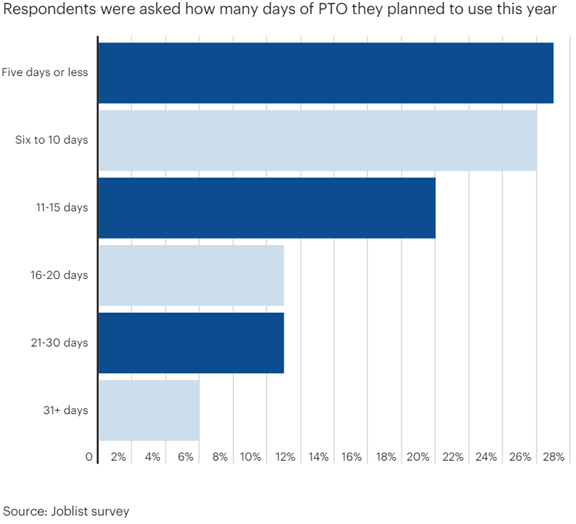As summer comes to an end, some people are wondering why they’re still feeling burnout. A potential reason for this lingering feeling is due to not taking, or not taking enough, time off from work.
It’s important to remember that U.S. employers aren’t federally mandated to offer time off for relaxation, and if they choose to do so, time off provided may be paid or unpaid. The details can vary even further with some employers offering dedicated paid vacation time and others offering a pool of paid time off (PTO) that can be used for any reason, such as illness or personal reasons.
On average, American employees in the private sector receive 10 days of paid time off a year and only use 6.5 of those days. In 2018, American workers failed to use a total of 768 million days of paid time off.
Although this may not sound like a huge problem for employers, it can have negative and costly consequences. Let’s dig into the reasons why employees fail to take the time off they need and what you can do to encourage a healthier, happier workplace.
The Challenges of Taking Time Off
It’s difficult for employees to prevent burnout without ample time off — mentally and physically. Yet, according to a 2022 report by Zippia, 55% of American employees don’t use all of their allocated time off. So, what stands in their way?
- The American Tradition of “Hard Work”
Embedded deeply in American society is the notion that anything can be achieved through hard work. When taken to an extreme, productivity becomes a measure of self-worth. This can lead individuals to feel guilt or shame for perceived laziness when taking time off, so they simply avoid it instead.
- Hustle Culture
A lot of companies encourage workaholic behavior which contributes to employees passing up vacation time. Just 41% of employees felt that their company culture encouraged time off according to a report by the American Psychological Association. Employees may feel like leaders will see them as less committed to their work or worry that their job might be at risk if coworkers can handle their workload during their absence. Because employees want to make a good impression, they are likely to push through, stay late, and avoid time off.
- Work Overload
The same APA report found that one-third of employees feel their workload makes it difficult for them to take any time off. Of the employees that do take time off, 42% dread returning, and 49% say they come back to an even heavier workload that piled up in their absence. For some, the amount of work surrounding vacation is so great that it’s not worth the hassle.
- Not Enough Time
Employees rely on their employers to set time off parameters, and the average worker receives only ten days of paid vacation and six paid holidays annually. Since there is no mandate in the U.S., 25% of the workforce receives no time off at all. When workers don’t receive ample time away or are forced to struggle with lost income because time off is unpaid, they don’t reap the benefits of recovery and become susceptible to burnout.
- Employer Expectations
Even when employees do take time off, they often feel as though they can’t really unplug from work. According to a Qualtrics study, 49% of people say they typically work at least an hour a day while on vacation, with 24% saying they work three hours a day or more. Also, while on vacation, 31% of people say they are expected to answer phone calls or texts, 27% say they are expected to respond to emails or messages, and 20% say they are expected to be online. It’s not enough just to get away from the office physically. Individuals need the mental break that vacation provides as well.

Why Vacation Time Is Important
When workers don’t take the appropriate amount of time off, it’s likely to lead to burnout and negative business outcomes. On the other hand, a robust and flexible time off program coupled with an encouraging environment can save money and improve profits in several ways:
- Better recruitment and retention
- Reduced levels of unscheduled absenteeism
- Increased productivity
- Positive attitudes toward work, coworkers, customers, and the company
- More energy and focus to take on challenges
- Better physical and mental health of employees
Tips for Employers
If you want to enjoy the rewards of a healthy workplace, offering paid time off is a great first step, but it may not go far enough. Even in companies that offer unlimited PTO, employees will feel pressured to stay at work if employers don’t create a culture where rest and recovery are valued. Here are a few things you can do to ensure employees get the time off they need to perform their best:
- Do not require or expect employees to work while on PTO
- Ask managers to work with their employees to pre-plan for time off
- Encourage time off by making the process easy and responding positively to requests
- Consider increasing PTO to employees over the course of their tenure
- Let employees use their PTO in ways that make sense for them by being as flexible as possible
At the end of the day, time off from work should be just as important to employers as it is to their workers. By understanding what gets in the way, you can create a time off program that works in your unique situation and supports the happy, healthy workforce your company needs.
At FrankCrum, our mission is to help businesses become the best they can be. To learn more about our comprehensive services, contact us today.



